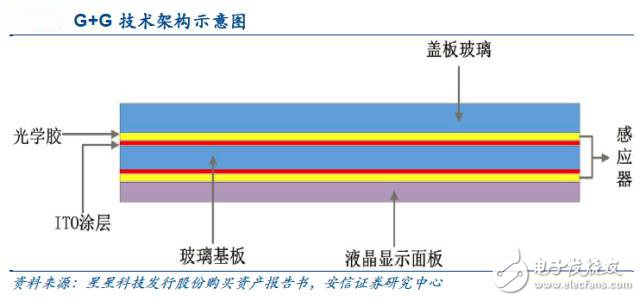Touch sensor is an important electronic component of capacitive Touch Screen. In the era of TFT-LCD, Out-Cell, In-Cell and On-Cell, these technologies have their own characteristics. In-Cell and On-Cell are Apple and Samsung. monopoly. With the gradual growth of OLED, which kind of touch sensor will become the mainstream in the future?
TFT-LCD era: Out-Cell, In-Cell, On-CellThe touch sensor is an important electronic component of the capacitive touch screen. After receiving the touch signal, the touch sensor converts it into an electrical signal and transmits it to the touch IC through the FPC for calculation and analysis, thereby obtaining a coordinate signal of the touch point. At present, the sensor technology architecture of the capacitive touch screen is mainly divided into three types: Out-Cell, In-Cell and On-Cell. Among them, Out-Cell can be divided into three technologies: G+G, G+F and OGS. The main difference in technology is the difference in the number of ITO (Indium Tin Oxide) coated carriers and the number of layers and the location of the touch sensor.
In the era of TFT-LCD, Out-Cell, In-Cell, and On-Cell ranked the world, with G+F accounting for the highest proportion, reaching 49.3% in 2015, followed by In-cell and On-Cell, totaling 40.6%. WitsView expects that the market share of In-cell and On-Cell will reach 47.8% in 2016, while G+F will decrease to 44.3%.
G+G, G+F: three-tier architecture, mainly used in low-end mobile phonesG+G technology was developed by Apple Inc. and applied to the iPhone's first generation of mobile phones. The G+G touch sensor is located between the cover glass and the display module, and its structure is supported by a glass substrate. The ITO conductive coating is respectively plated on both sides of the glass substrate, and the advantage is that the light transmittance is good (because the glass substrate is used). The disadvantage is that the thickness is thicker and does not meet the development direction of “slim and short†of smart phones. At present, in the low-end market, G+G technology has been basically replaced by G+F technology; in the high-end smartphone and tablet market, G+ G technology has been largely replaced by OGS, In-Cell and On-Cell technologies.

The G+F touch sensor is also located between the cover glass and the display module. The structure is supported by the PET film substrate. The ITO conductive coating is coated on the surface of the PET film, and the position of the ITO conductive coating and the number of conductive film layers are different. It can be divided into GFF, GF2, G1F and other specifications. Taking GF2 as an example, its structure is as follows.

Advantages of G+F: The cost is the lowest among all touch technologies and the thickness is thinner than G+G (because of the PET film substrate), the current transmittance can be similar to G+G. G+F touch technology mainly accounts for the market share of low-end and mid-range mobile phones.
OGS, In-Cell, On-Cell: two-tier architecture, full-fit mobile phone is the development directionA mobile phone equipped with a G+G or G+F touch module has a three-layer structure: a cover glass, a touch sensor, and a display module. The difference is OGS, In-Cell, On-Cell three technical architectures, these three technologies embed the touch sensor in the cover glass or display module, so only the "two-layer" architecture: cover glass And the display module, and the touch panel will become thinner.
Specifically, the OGS technology directly etches the touch function sensing line on the cover glass, thereby combining the cover glass and the touch sensor in the touch screen module, thereby reducing a layer of glass or PET film substrate. In turn, the effect of improving the light transmittance, reducing the number of bonding, and reducing the thickness of the touch screen module is achieved.
The In-Cell touch technology mounts the touch sensing line inside the display panel, and the touch sensor function is embedded in the box formed between the TFT array substrate and the color filter film, which can effectively reduce the use of various materials such as optical glue, and increase Light transmissive while reducing the thickness of the display device; On-Cell touch technology mounts the sensing line on the upper surface of the color filter glass of the display panel, by forming a simple transparent electrode pattern between the color filter and the polarizer Embed the touch screen. The main features of the difference between In-Cell and On-Cell are: In-Cell's touch sensor is located below the color filter, and On-Cell's touch sensor is located above the color filter.
Since the touch panel equipped with OGS, In-Cell, and On-Cell touch technology has only a "two-layer" architecture, which is in line with the development direction of "short, light and thin" smartphones, it has occupied a position in the TFT-LCD era. In addition to the "light and thin" user demand, the rise of full-fit requirements has also led to the development of touch technology to OGS, In-Cell, and On-Cell.
The so-called full fit, a simple understanding is whether there will be a "void" when the cover glass, the touch sensor, and the display module are "sticked together". If there is a "gap", it is called a non-full fit. If there is no "void", it will become a full fit. The “void†is the air layer. The presence of the air layer tends to cause the screen of the mobile phone to enter the ash, and at the same time, it has the disadvantages of poor display performance and power consumption. Since G+G and G+F technologies have three layers of “architectureâ€, no matter how “pasteâ€, there will be a certain air layer. Although the air layer can be filled with OCA optical glue, there is still insufficient permeability and light reflectance. Increased problem. The OGS, In-Cell, and On-Cell technologies only have two layers of "architecture". When using the full-fit technology, the air layer will not be generated. It is the future development direction of the touch panel, and is also a high-end smartphone in the TFT-LCD era. Standard configuration.
Touch Screen
Jumei Video(Shenzhen)Co.,Ltd , https://www.jmsxdisplay.com